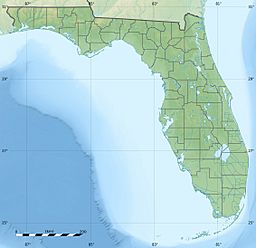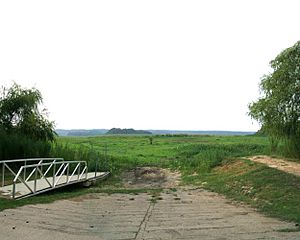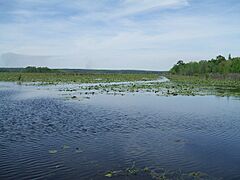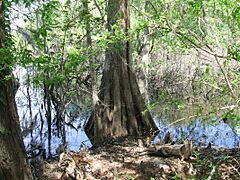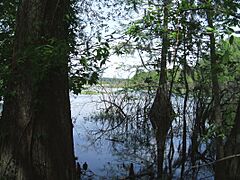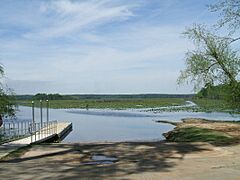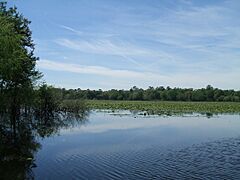Lake Iamonia facts for kids
Quick facts for kids Lake Iamonia |
|
|---|---|
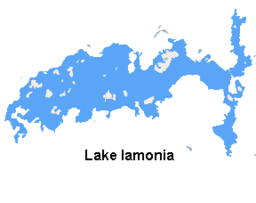
map
|
|
| Location | Leon County, Florida |
| Coordinates | 30°37′59″N 84°10′40″W / 30.633120°N 84.177674°W |
| Type | prairie lake; Oligotrophic to Mesotrophic |
| Catchment area | 101 sq mi (260 km2) |
| Basin countries | United States |
| Max. length | 7 mi (11 km) |
| Max. width | 2 mi (3 km) |
| Surface area | 5,757 acres (2,330 ha) |
| Surface elevation | 95 ft (29 m) |
Lake Iamonia (pronounced eye-MOH-nyuh) is a big, warm-climate lake in northern Leon County, Florida, United States. It's known as a "prairie lake" because it can sometimes dry up, turning into a grassy plain. This unique lake was formed thousands of years ago.
Contents
History of Lake Iamonia
How Lake Iamonia Was Formed
Lake Iamonia started forming during the Pleistocene Ice Age, a very long time ago. As huge ice sheets far to the north grew and melted, sea levels changed a lot. Sometimes the land where the lake is now was underwater, and sometimes it was dry land. These changes helped create the shape of Lake Iamonia over thousands of years.
Ancient Animals of the Lake Area
The area around Lake Iamonia was once home to many huge, ancient animals. Fossils found nearby show that creatures like "bear-dogs" (which looked like a mix of bears and dogs) and early dog-like animals lived here. Scientists have also found bones of ancient camels and horse relatives. One ancient dog, called Osbornodon iamonensis, was even named after the lake!
Native American History at the Lake
For a very long time, different groups of Native Americans lived around Lake Iamonia. The Woodland culture, especially the Weeden Island culture, lived here from about 200 BCE to 750 AD. Later, the area was part of the Apalachee Province. The Seminole people also made their homes near the lake. The name "Iamonia" comes from a Seminole town called “Hiamonee,” which was located by the Ochlockonee River.
Where is Lake Iamonia?
Lake Iamonia is located in a hilly area called the Red Hills Region of Florida. It covers about 5,757 acres (23 square kilometers). The lake is about 7 miles (11 kilometers) long and up to 2 miles (3 kilometers) wide. The area that drains into the lake is roughly 101 square miles (260 square kilometers).
Several roads run near the lake. County Road 12 is along the north side. The Tall Timbers Research Station and Land Conservancy is also on a bluff overlooking the north side. The lake's eastern edge is close to US 319, and the south side borders neighborhoods like Killearn Lakes Plantation. The west side is near State Road 155. The highest point around the lake is about 220 feet (67 meters) above sea level.
Lake Details and Water Levels
Lake Iamonia is known for having very clean water, especially on its eastern side. It's classified as "oligotrophic" to "mesotrophic," which means its water is clear and has low to medium amounts of nutrients. The lake sits about 95 feet (29 meters) above sea level.
Its average depth is about 7 feet (2 meters), but it can be as deep as 40 feet (12 meters) in some spots. The lake is surrounded by a large area of land (about 4,000 acres or 16 square kilometers) that is protected for conservation.
The amount of water in Lake Iamonia changes a lot. It gets water from its own surrounding land and from the Ochlockonee River. Heavy rainfall, even in Southwestern Georgia, can also make the lake level rise. For example, in 2008, the Ochlockonee River flooded and refilled the entire dried-up lake in just three days!
Dams and Dikes Around the Lake
Over the years, people built structures to control the water in Lake Iamonia.
- In 1910, a dam was built on the western side. This dam was meant to separate the lake from the Ochlockonee River. The goal was to let the lake dry out so farmers could use the land for growing crops.
- In 1940, a large earthen dike was built around a "sink basin" (a natural drain) to help keep water in the lake. A concrete spillway with metal pipes and sluice gates was added to manage overflow.
- Before 1950, more earthen dams were built across smaller parts of the lake, like Cromartie Arm and Strickland Arm. These dams helped keep water in those areas for nearby plantations.
By the 1970s, many aquatic plants were growing in the lake. In 1978, the Florida Fish and Wildlife Conservation Commission tried to install new structures to control water levels, but they were damaged and removed. Today, the sluice gates at the sink basin are kept open, so water drains continuously from that area. This sink area is very deep, going down about 400 feet (122 meters).
The "Prairie Stage"
In the 1800s, Lake Iamonia was surrounded by large plantations. During dry periods, which happened naturally, the lake would sometimes dry up. When this happened, the lake bottom would become covered in rich grasses and plants. Plantation owners would then use this land to graze their cattle and sheep. This is why it's called a "prairie lake"—it can turn into a grassy prairie!
Animals of Lake Iamonia
Mammals of the Lake Area
Many different mammals live around Lake Iamonia, including:
- Beavers
- Bobcats
- Various types of rats and mice
- Coyotes
- Gray foxes and red foxes
- Gray squirrels and fox squirrels
- Marsh rabbits
- Nine-banded armadillos
- Opossums
- Raccoons
- River otters
- White-tailed deer
Fish Found in the Lake
Lake Iamonia is a popular spot for sport fishing. You can find many kinds of fish here, such as:
Reptiles Living in and Around the Lake
The lake is home to many reptiles, including:
- American alligators
- Various types of snapping turtles, like the Florida softshell turtle and peninsular cooter
- Many kinds of snakes, such as the Florida green water snake, cottonmouth, and the protected eastern indigo snake
Amphibians of Lake Iamonia
Amphibians found here include:
- Pig frogs
- Bullfrogs
- Green tree frogs
- Two-toed amphiumas (a type of salamander)
- Central newts
Gallery
The photos show Lake Iamonia at a normal level of water.


